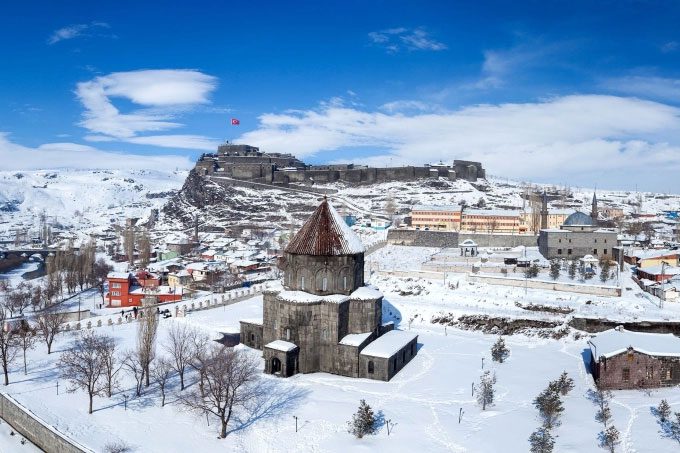Tickets for this train journey are very difficult to purchase as ticket outlets often sell out within minutes of opening.
Turkey is the final destination of one of the most famous trains in the world, the Orient Express – the legendary train that departs from the capital city of Paris (France) to the city of Istanbul (Turkey).
Now, another train, known as the Dogu Express, is making Turkey one of the top railway tourism destinations in the world.
Dogu Express, also known as the Eastern Express, is a train service connecting the capital Ankara to the city of Kars (Turkey). Although it is a commercial train aimed at serving travel needs, the image of Dogu Express has been widely shared on social media due to the stunning landscapes along its route.

A tourist taking a selfie with friends before the Dogu Express train departs from Ankara.
Berry Romo, a travel blogger who has lived in Turkey for over a decade, shared: “Trains are a very popular mode of transport for locals and domestic tourists, but they are hardly known by foreign travelers.”
To meet the increasing demand, the Dogu Express was converted for tourism purposes in 2019. The journey on the white train with red and navy blue trim lasts over 30 hours, traveling from the bustling capital Ankara to the fairytale snowy land of Kars, covering a distance of 1,310 km with stops along the way, where tourists can partake in short city tours.
However, tickets for this train are very difficult to obtain as ticket outlets often sell out within minutes.
The main reason for this quick sell-out is that Turkish travel companies typically buy tickets in bulk to resell for their organized tours, ensuring their customers have a seat on the train.
Individual tickets can only be purchased a month in advance, making it a coveted item for many. According to blogger Romo: “The secret is to check the company’s website at midnight; when they go on sale, buy immediately.”
Ankara, the capital where the Dogu train begins
At first glance, Ankara may appear less glamorous than the famous city of Istanbul, but it is the political center of Turkey, making it a worthwhile stop.
Top landmarks in Ankara include the Ataturk Mausoleum, the final resting place of Turkey’s first president, Mustafa Kemal Atatürk. The complex is divided into four parts.

Tourists often decorate their cabins with string lights, scarves, and candles.
Notably, the Peace Park features a Turkish flag shape made from pebbles and surrounded by flower carpets; and the Ceremonial Plaza leads to the Hall of Honor, which houses Ataturk’s tomb.
Although Ankara’s appearance began to change rapidly after becoming Turkey’s new capital in 1923, it still retains charming ancient beauty, especially in the old neighborhoods, with Ulus being the most famous, where remnants of the Roman Empire can still be seen, along with preserved walkways and even an ancient castle atop a hill.
From here, visitors can enjoy a panoramic view of the surroundings. Additionally, in Ulus there is Sanat Sokağı, also known as Arts Street, which features a row of old-style houses that have been restored and converted into cafes, craft shops, and Roman souvenir stalls.
For a more modern experience in Ankara, visitors can head to CemModern, an art gallery that hosts global exhibitions in a restored railway warehouse. Cultural events here vary widely, from film screenings to yoga sessions and markets.
From the bustling capital to vast and peaceful countryside
The Dogu departs around early evening, and as it leaves Ankara’s train station, travelers will witness a distinct change, transitioning from a crowded and bustling urban area to land with vast and tranquil landscapes.
The sleeping cabins of the Dogu train are equipped with two single bunk beds that can be converted into seating during the day, a mini-fridge, and a sink.

The train travels through the vast lands of eastern Turkey.
Travelers can decorate their compartments with string lights, tablecloths, and candles provided. According to blogger Berry Romo: “This is truly a great idea for passengers to enjoy the beautiful scenery outside while in a cozy space.”
On the following morning, the Dogu arrives at Ilic, a small village with an incredibly attractive destination known as Karanalik Canyon, or Dark Canyon. Dark Canyon is traversed by the adventurous Stone Road, which goes through 38 tunnels and features terrifying bends that challenge anyone.
Despite its reputation for danger, Dark Canyon frequently attracts tourists with its stunning scenery. It boasts impressive cliffs and steep gorges, all with the waters of the Euphrates River flowing through.
After that, the train heads further east into the central Anatolia region. Netta Kalpan, a native of Minnesota living in the Black Sea region of Trabzon, although used to harsh snowy winters, stated: “I had no idea how vast, flat, and cold Turkey could be until I stepped onto the Dogu train and had the chance to visit Anatolia. I was holding my phone and continuously capturing the beauty of this place, but it couldn’t capture the real feeling of standing before such vastness.”
The final destination
As night falls, the Dogu reaches Erzurum. Berry Romo noted that visiting this city was one of the best experiences she had in Turkey due to its rich history, culture, and unique cuisine.
Erzurum is home to many different local dishes, the most famous being Cag Kebab. Lamb is marinated for about 12 hours with onions, salt, and pepper, then skewered and grilled over wood fire before being served in warmed bread or eaten directly without bread.

After Erzurum, the Dogu Express is just a few hours away from its final destination, Kars.
Famous for its winter fairytale landscapes, its name is derived from the Turkish word meaning snow. The city is known for its unique architecture stemming from its days as part of Russia.
Ummu Altunas, a lawyer from Istanbul, likened visiting eastern Turkey to stepping into a “completely different country” compared to western Europe. She stated that this is partly because “the east is home to many different cultures”, such as Kurdish, Armenian, and Assyrian peoples.
The medieval city of Ani, the former capital of the ancient Armenian Kingdom, is one such example. Just a short drive from Kars, its majestic ruins dating back 1,600 years are always open to tourists. The vast walls and well-preserved churches overlooking the deep gorge offer visitors a wonderful journey back in time.




















































